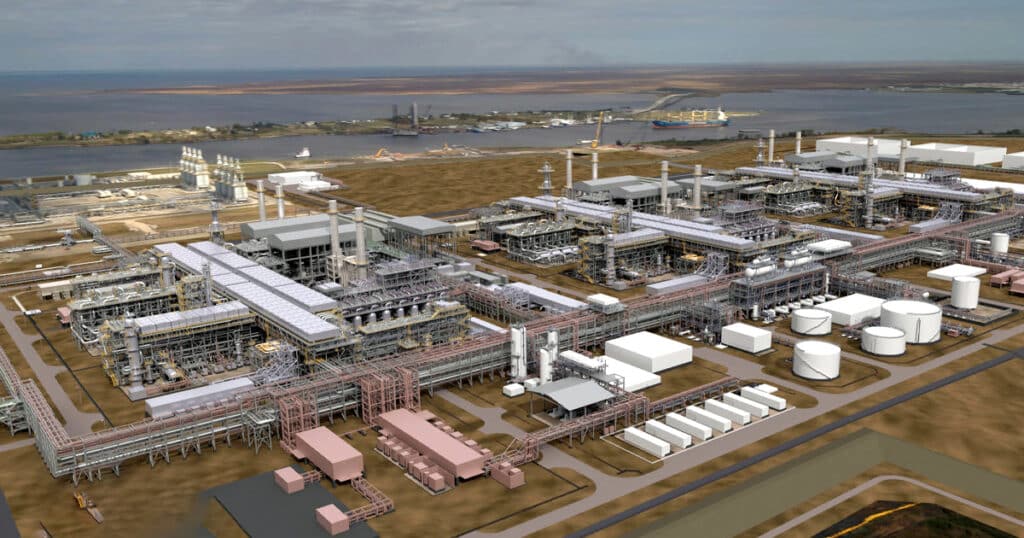
US is top exporter of liquified natural gas in first half of 2023, led by Gulf states
The U.S. exported more natural gas in the first six months of 2023 than in any other previous six-month period, the U.S. Energy Information Agency reported.
U.S. companies averaged 12.5 billion cubic feet per day (Bcf/d) in the first six months of this year, an 11% increase from their average over the same period last year. This is after in May of this year, the U.S.’s “net natural gas exports as liquefied natural gas (LNG) and by pipeline averaged a monthly record high of 13.6 Bcf/d.”
It’s also after the U.S. in 2017 became a net exporter of natural gas for the first time since 1957, “primarily because of increased LNG exports,” the EIA says. The U.S. became a net exporter after Cheniere Energy was the first to export domestically sourced LNG from the Sabine Pass LNG Terminal in Cameron Parish, Louisiana, and from the Port of Corpus Christi in Texas.
LNG is natural gas that’s been cooled to -260°F. By changing its state from gaseous to liquid form, LNG “is 600 times more compact, making it much easier to transport and distribute to places where pipelines are not available,” Texans for Natural Gas explains.
Average natural gas deliveries to U.S. LNG export terminals increased by 7.1% (0.9 Bcf/d) week over week in the first half of 2023, the EIA reports, averaging 13.0 Bcf/d, “the highest weekly average since May.” Natural gas deliveries to terminals in South Louisiana increased by 8% and to terminals in South Texas by 6.4%. The majority of LNG-carrying capacity vessels also depart from Louisiana and Texas ports, it notes.
Over a 10-year period, U.S. natural gas demand, which includes domestic consumption and gross exports, increased by 43%, the EIA also reported. This translates to 34.5 billion cubic feet per day (Bcf/d) from 2012 to 2022.
As a result, demand in the Gulf Coast states of Louisiana and Texas grew by 116%. This is due to several factors, including increased demand for feedgas for LNG exports and increased natural gas-fired electric power generation, which was partially due to states moving away from using coal as an energy source.
The U.S. “leads the world in reducing carbon dioxide emissions, in large part thanks to the increased use of natural gas in the power sector,” Texans for Natural Gas states. “Natural gas has 55% lower carbon dioxide emissions than coal, which means when switching from coal to natural gas for power generation, the GHG savings are immense.”
The U.S. became the world’s largest LNG exporter in the first half of 2022, led by Texas, when Texas energy production and export infrastructure and the Port of Corpus Christi helped provide a lifeline to European countries, TNG notes. Nearly 75% of all U.S. exports went to Europe in the first half of 2022 as E.U. countries and the U.K. decreased their reliance on Russian-piped natural gas by 40%, a Texans for Natural Gas analysis found.
In the first six months of 2022, more than 90 million tons of LNG moved through the Port of Corpus Christi to Europe, according to the report. TNG also estimated that 96% of the additional planned U.S. LNG export capacity located in the Gulf of Mexico will largely be supplied by Texas.
“Texas is providing energy security not just for the United States but for the world. Texas energy – from our wells in West Texas to our ports along the Gulf of Mexico – enabled America to meet European gas needs in a time of crisis,” TIPRO president and TNG spokesperson Ed Longanecker said.
Natural gas production is also expected to expand in the Permian Basin after five pipeline projects in Texas are completed and fully operational.
If Texas were its own country, it would be the world’s third-largest producer of natural gas and fourth-largest producer of oil.


